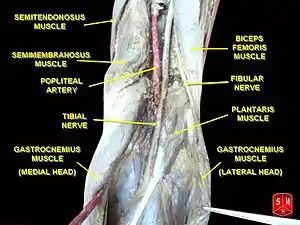Popliteal artery entrapment syndrome
The popliteal artery entrapment syndrome is an uncommon pathology which results in claudication and chronic leg ischemia. The popliteal artery may be compressed behind the knee, due to congenital deformity of the muscles or tendon insertions of the popliteal fossa. This repetitive trauma may result in stenotic artery degeneration, complete artery occlusion or even formation of an aneurysm.
| Popliteal artery entrapment syndrome | |
|---|---|
 | |
| Normal course of the popliteal artery at the back of the knee |
Classification
Love and Whelan proposed a classification of this pathology into four types,[1] according to the various relationships between the popliteal artery and the muscles of the popliteal space. Other classification systems exist.
Diagnosis
Differential diagnosis
Exercise induced lower leg pain includes chronic exertional compartment syndrome,[2] unresolved muscle strain (this classically occurs at the musculotendinous junction of the medial head of gastrocnemius), medial tibia stress syndrome, fibular and tibial stress fractures, fascial defects, nerve entrapment syndrome, vascular claudication (atherosclerotic or popliteal artery entrapment syndrome) and referred pain from lumbar disc herniation.[3]
Epidemiology
In the general population, popliteal artery entrapment syndrome (PAES) has an estimated prevalence of 0.16%.[4] It is most commonly found in young, physically active males.[5] In fact, sixty percent of all cases of this syndrome occur in athletically active males under the age of 30.[6] The predilection of this syndrome presents in a male to female ratio of 15:1.[4] This discrepancy in prevalence may be partially attributed to the findings that males are generally found to be more physically active than females or because a large portion of the data accumulated for PAES is from military hospitals that treat mostly male populations.[6] The prevalence of PAES varies through different populations; it increases in those who participate in running, soccer, football, basketball, or rugby.[7] During embryonic development, the medial head of gastrocnemius migrates medially and superiorly. This migration can cause structural abnormalities, such as irregular positioning of the popliteal artery, and can account for the rare instances of entrapment caused by the popliteus muscle.[6] Less than 3% of all people are born with this anatomical defect that progresses into PAES, and of those who are born with the anatomical defect, the majority never develop symptoms.[7] Bilateral presentation of PAES is found in approximately 25% of cases.[6]
History
The syndrome was first described in 1879 by Anderson Stuart, a medical student, in a 64-year-old male. Hamming and Vink in 1959 first described the management of the popliteal artery syndrome in a 12-year-old patient. The patient was treated with myotomy of the medial head of the gastrocnemius muscle and concomitant endarterectomy of the popliteal artery. They later reported four more cases and claimed that the incidence of this pathology in patients younger than 30 years old with claudication was 40%. Servello was the first to draw attention to diminished distal pulses observed with forced plantar- or dorsiflexion in patients with this syndrome. Bouhoutsos and Daskalakis in 1981 reported 45 cases of this syndrome in a population of 20,000 Greek soldiers. During recent years the increasing frequency with which popliteal artery entrapment is reported, strongly suggests a greater awareness of the syndrome.
References
- Love J, Whelan T (1965). "Popliteal artery entrapment syndrome". Am J Surg. 109 (5): 620–4. doi:10.1016/S0002-9610(65)80016-2. PMID 14281885.
- Bong MR, Polatsch DB, Jazrawi LM et al. Chronic exertional compartment syndrome: diagnosis and management.Bull Hosp Jt Dis. 2005;62(3-4):77-84.
- Locke S. Exercise related chronic lower leg pain. Aust Fam Physician 1999; 28:569–573.
- "Popliteal Artery Occlusive Disease: Background, Problem, Epidemiology". 2016-04-10.
{{cite journal}}: Cite journal requires|journal=(help) - Sharma, Aditya (2014). "Conditions Presenting with Symptoms of Peripheral Arterial Disease". Seminars in Interventional Radiology. 31 (4): 281–291. doi:10.1055/s-0034-1393963. PMC 4232436. PMID 25435652.
- Stager, Andrew; Clement, Douglas (2012-09-23). "Popliteal Artery Entrapment Syndrome". Sports Medicine. 28 (1): 61–70. doi:10.2165/00007256-199928010-00006. ISSN 0112-1642. PMID 10461713. S2CID 26958095.
- "Popliteal Artery Entrapment Syndrome (PAES) | Cleveland Clinic". Cleveland Clinic. Retrieved 2016-12-19.